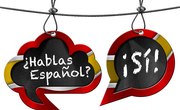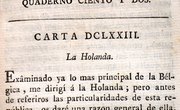Knowing the adequate amount of Spanish vocabulary and grammar will ensure that you pass your Spanish class without much difficulty. By employing certain studying methods, you will optimize your time spent and the amount of information you retain. Flashcards and conjugation charts are two of the most popular studying tools used in foreign language classes.
Creating and Using Flashcards
Step 1
Fold the top and bottom of a piece of paper in half horizontally, and then fold the folded paper in half horizontally.
Step 2
Unfold the paper and then fold it in half again, this time vertically. The paper should now be divided into eight rectangles.
Step 3
Cut out each rectangle. These will be your flashcards.
Step 4
Write a different English word on one side of each of your flashcards, and its corresponding Spanish translation on the other side.
Step 5
Flip through each flashcard, starting with the Spanish sides. Try to recall the corresponding English word for each one.
Step 6
Put the flashcards that were easy for you in one pile and the ones that gave you trouble in another pile. Keep practicing with the ones that are more difficult for you until you are able to remember them all.
Step 7
Repeat the process, this time starting with the English sides and trying to recall the Spanish translations. This will be much harder.
Making Conjugation Charts
Step 1
Create a chart that has four columns and four rows. Write "Verb" in the top-left cell and "English Meaning" in the third cell of the first row.
Step 2
Write "Yo" ("I") in the first cell of the second row, "Tú" ("You" -- familiar use) in the first cell of the third row, and "Él/Ella/Usted" ("He"/"She/"You" -- formal use) in the fist cell of the fourth row.
Step 3
Put "Nosotros" ("We") in the third cell of the second row, "Vosotros" ("You" -- familiar use, plural) in the third cell of the third row, and "Ellos/Ellas/Ustedes" ("They" -- males/"They" -- females/"You" -- formal use, plural) in the third cell of the fourth row.
Step 4
Practice verb conjugations by filling in the empty cells of your conjugation chart. For example, put the verb "Hablar" in the "Verb" cell, and "To speak" in the "English Meaning" cell.
Step 5
Conjugate the verb for each form using the blank cells next to each pronoun. For example: "yo hablo," "tú hablas," "él/ella/usted habla," "nosotros hablamos," "vosotros habláis," "ellos/ellas/ustedes hablan."
Step 6
Repeat this process by making more tables to practice your conjugation, paying special attention to irregular but commonly occurring verbs such as "ser," "estar," "hacer," "decir," "saber," "tener," "venir" and "salir."
Related Articles
References
Writer Bio
Riley Sawyer has been a freelance writer and journalist since 2009, specializing in medical, legal and technical writing. His articles have appeared in online publications and journals for organizations such as the SoCal Crime Prevention League. Sawyer is a forensic-science student at the University of California.










